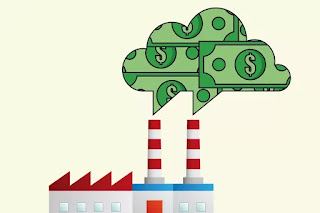Carbon taxes are in the news these days. In recent months, not one but two conservative national carbon tax proposals have emerged, disrupting the usual partisan dynamic on climate policy.
First there was the proposal from the Climate Leadership Council, a group of (mostly older, retired) Republicans and centrists, which was but recently gained the backing of a new big-money conservative PAC. And next week, Rep. Carlos Curbelo (R-FL), co-chair of the House Climate Solutions Caucus, plans to release a carbon-tax proposal of his own.
Neither proposal has a snowflake’s chance in hell of passage any time soon. And on Thursday, the House passed a resolution trying to squash even the possibility of a carbon tax. But the existence of these proposals does indicate a heightened level of awareness of and interest in carbon taxes. So now seems like a good opportunity to review some of the basics.
Luckily, the Center on Global Energy Policy (CGEP) at Columbia University (in conjunction with several other research organizations) has just issued a series of four research papers covering those basics. The research didn’t turn up anything particularly shocking; it mostly confirmed what policy wonks have long understood about the dynamics of carbon taxes.
But those dynamics aren’t necessarily well understood by the public. With the (slim but growing!) chance that a federal carbon tax could be the subject of serious national debate, it’s a good time for everyone to get up to speed.
A carbon tax is just what it sounds like — a per-ton tax on the carbon dioxide emissions embedded in fuels or other products. (Other greenhouse gases, like methane, are translated into their carbon dioxide equivalent, or CO2e, for easier comparison.)
Here are the top five questions advocates, policymakers, and informed citizens should be asking about a carbon tax:
- Can it reduce greenhouse gas emissions?
- What economic sectors will it hit hardest?
- What overall effect will it have on the US economy?
- Will it be fair and equitable?
- Will it be enough to address climate change?
...
Carbon taxes are a useful tool but a dangerous fetish
To me, all of the above suggests a simple conclusion: Carbon taxes are good policy, an important part of the portfolio, but unlikely ever to be sufficient on their own. It’s worth getting a price on carbon anywhere it can be gotten, but climate hawks should not believe, and definitely shouldn’t be saying in public, that a carbon price is enough, that it’s worth trading anything and everything for, that when we implement it, we are done.
For one thing, it’s unlikely to be high enough. For another, it strikes me as unwise to leave other sectors unreformed for a decade or two while we clean up electricity. If that happens, we could reach 2030 or 2040, run out of coal to retire, and find ourselves needing very rapid, very large reductions from those other sectors, for which we will be ill-prepared.
I asked Kaufman, the director of Columbia’s School of International and Public Affairs, about this as well. He noted that “it’s a feature rather than a bug of a carbon tax policy that its near-term effects are concentrated in one industry.” That should serve to reduce political opposition from oil and gas.
But he also added, “if I were developing an optimal climate policy portfolio, I’d absolutely include a host of other policies, like funding clean transportation infrastructure, efficiency standards, and a boatload of support for innovation.”
John Larsen, director of the Rhodium research, told me that the sectoral analysis of carbon tax effects can show policymakers “where to focus additional policy action.”
“A very reasonable case can be made from our results,” he said, “that more action across the economy is required if the US is going to do its fair share in tackling climate change.”
Carbon pricing, whatever form it comes in, will almost certainly need to be supplemented with technology research, development, and demonstration policies; pollution regulations; and spending on infrastructure, adaptation, and transition assistance. A carbon price supports, funds, and accelerates the effects of those other policies (which is great!), but it is not a substitute.
The proper target for advocacy is action sufficient to reduce emissions to net-zero carbon as fast as practicably possible. What limits that effort is not ultimately the choice of policy instruments, but the constraints of political attention, organization, funding, and intensity. Loosen those constraints and everything, including a carbon tax, gets easier.
Read more at The 5 Most Important Questions About Carbon Taxes, Answered

No comments:
Post a Comment